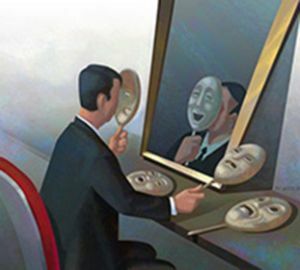 Paraphrenic syndrome( paraphrenia) refers to the most severe forms of delusional disorder. The first one was described by Emil Kraepelin at the beginning of the last century. According to the International Directory of Diseases( ICD-10), this syndrome refers to paranoid schizophrenia.
Paraphrenic syndrome( paraphrenia) refers to the most severe forms of delusional disorder. The first one was described by Emil Kraepelin at the beginning of the last century. According to the International Directory of Diseases( ICD-10), this syndrome refers to paranoid schizophrenia.
The disease manifests itself in the form of megalomania, ideas of persecution. Patients consider themselves to be all-powerful, rich and successful people who are at the center of grandiose events. Distorted perception of reality can be combined with visual and auditory hallucinations.

Paranoid, paranoid and paraphrenic syndromes - step by step from prudence to insanity. ..
Factors provocateurs: theories and assumptions
It is not yet possible to establish the exact cause of the appearance of paraphrenia in modern medicine. However, specialists identify several main factors that can affect the development of this pathology:
- Heredity. Often, the disease is diagnosed in people whose close relatives also had a paraphrenic syndrome.

- Violation of the brain in connection with the imbalance of neurotransmitters and problems with the exchange of impulses between nerve cells.
- Environment. The onset of the development of the disease can be caused by loneliness, a frequent depressive state, the use of drugs and alcoholic beverages.
- Paraphrenia, as a concomitant disease, occurs in chronic forms of paranoid and paranoid syndromes. Sometimes the disease manifests itself after a head injury or with senile marasism.
Clinical picture of
With paraphrenic syndrome, the following symptoms are observed:
- delusional ideas( persecution, overestimation of self-importance);
- hallucinations or pseudo-hallucinations;
- behavior of a fictitious character( communication with aliens or famous people);
- the patient does not try to convince others in his stories, he sincerely believes in his story;
- sharp mood swings, but a rare finding in a depressed state.
In addition, the patient may additionally manifest Kapgra syndrome, characterized by the presence of a substitute for his double. A person explains the reason for attributing to him bad deeds by the actions of his twin or a non-existent twin. With such pathology, the patient may not recognize people from his or her close environment and family, but can see the native person in a stranger.
In general, the symptoms of paraphrenia indicate the progression of mental illness and worsening of the patient's condition.
Classification with the features of the
clinic Depending on the characteristics of the symptomatology, it is customary to distinguish several types of paraphrenic syndrome:
- Hallucinatory .The patient hears internal and external voices, which inspire delusions to him, and also distort the
 reality. In this state, the patient rarely enters into a dialogue with others, proving his rightness.
reality. In this state, the patient rarely enters into a dialogue with others, proving his rightness. - Systematized .Ideas are sustainable. They are orderly, although they are delusional. This kind of disease is characterized by a pronounced megalomania, superiority and negative attitude towards people around. This behavior is accompanied by auditory as well as visual hallucinations.
- Confabulator .The patient combines exaggerated conceit and memories of non-existent events in which he took heroic part. This type of disorder rarely occurs on its own. It usually arises from the complication of hallucinatory and systematized paraphrenia.
- Depressive or melancholic .The patient unreasonably considers himself guilty of actions he did not commit. He assures everyone that he deserves punishment and humiliation, at every opportunity tries to blame himself.
- Erotic .They are more likely to suffer from women. Usually the cause is problems in family life. The patient seems to be accused of immorality( adultery) and is promised to be punished by resorting to sexual violence. The disorder has a non-permanent character, and it arises from attacks.
- Late .It is diagnosed in people older than 70 years. Patients seem to be constantly infringed in rights and offended. Pathology refers to senile schizophrenia and is practically not amenable to treatment.
 Depending on the nature of the course of the disease, acute and chronic forms of paraphrenia are isolated. In the first situation, the disease occurs suddenly and has a pronounced change of behavior - from euphoria to depression, and vice versa. Brad in this case is not systematized and is usually described as particularly important( for example, saving the planet).
Depending on the nature of the course of the disease, acute and chronic forms of paraphrenia are isolated. In the first situation, the disease occurs suddenly and has a pronounced change of behavior - from euphoria to depression, and vice versa. Brad in this case is not systematized and is usually described as particularly important( for example, saving the planet).
With chronic illness, delirium is stable and systematized. Prevalent megalomania. Behavior does not have any drastic changes. The patient perceives his thoughts as true, and does not enter into disputes.
Diagnosis and differentiation from similar disorders
The main task in examining a patient with suspected development of a paraphrenic syndrome is to establish differences between similar disorders that indicate mental disorders. Paraphrenia is considered the most complex form of delusional state.
Therefore, special attention in this situation is given to differential diagnosis.
Symptoms of paranoid, paranoid and paraphrenic syndrome are similar. Therefore, it is possible to distinguish them among themselves only after revealing all pathological symptoms in the patient.
So, with paranoid syndrome, delusional ideas often arise against the background of a disturbed state of mind. In a paranoid syndrome, a person displays suspicion and mistrust, which subsequently can cause a persecution mania.
Paraphrenia should be distinguished from delusional conditions in adolescent psychosis or mental abnormalities as a result of taking psychotropic and narcotic drugs. Therefore, it is important to establish the duration and nature of the emerging  symptoms.
symptoms.
With paraphrenia, real things are replaced by fantastic ideas, brain functions are not violated. Therefore, this pathology is excluded from the examination of the doctor if problems are found during a neurological examination of the brain.
Paraphrenic syndrome is not considered a separate disease state.
For this reason, it is necessary to establish the disease that accompanies the corresponding symptoms, and treat it specifically, rather than individual manifestations of paraphrenia.
Complex of medical care
Only after careful diagnosis and establishment of an accurate diagnosis an adequate treatment course is prescribed. The approach to each patient must be individual, based on the characteristics of the symptoms of the disorder.
Therapy can be carried out both on an outpatient basis and within a hospital. Only in the first case is the condition of regular visits to a medical institution for taking a regular dose of medication.

Aminazine is one of the most popular agents for the treatment of delusional disorders
In the treatment most often used antipsychotics. They help to get rid of increased anxiety, delusions and hallucinations.
The determination of the necessary dosage and the duration of administration of the drugs depends on the characteristics of the course of the disease. In acute form, an increased dose is prescribed during a period of clinical symptoms.
Chronic disease requires minimal effective dosage with a gradual increase. In this case, drugs are taken continuously.
The hospital is most often placed patients in severe paraphrenic stage, when their behavior can become dangerous to others.
In case of diagnosing a depressive condition, psychotherapy and antidepressant therapy are additionally prescribed.
The treatment of mental disorders has difficulties with the establishment of a prognosis. According to statistics, only one in ten people after a complete treatment course permanently gets rid of paraphrenic syndrome.
In other cases, relapses occur over time. However, after passing the next treatment course in conjunction with psychotherapeutic procedures, the symptoms disappear, which means that a person can return to normal life without disability.
Can I be warned?
The main method of prevention is the timely diagnosis and treatment of the underlying provoking disease, and  prevention of complications. In the medical literature it is noted that the use of psychotropic drugs in the treatment of schizophrenia entails a reduction in the number of patients with the presence of paraphrenic syndrome.
prevention of complications. In the medical literature it is noted that the use of psychotropic drugs in the treatment of schizophrenia entails a reduction in the number of patients with the presence of paraphrenic syndrome.
In addition, a significant role in preventing the emergence of this pathology is the creation of a favorable emotional atmosphere. This should include the attention and care of parents about their children, the absence of quarrels in the family, visiting a psychologist, avoiding conflict situations at work.
The reception of psychotropic drugs must be agreed with the attending physician. In addition, one should not succumb to the negative influence of others with proposals for the use of narcotic drugs and alcoholic beverages.



